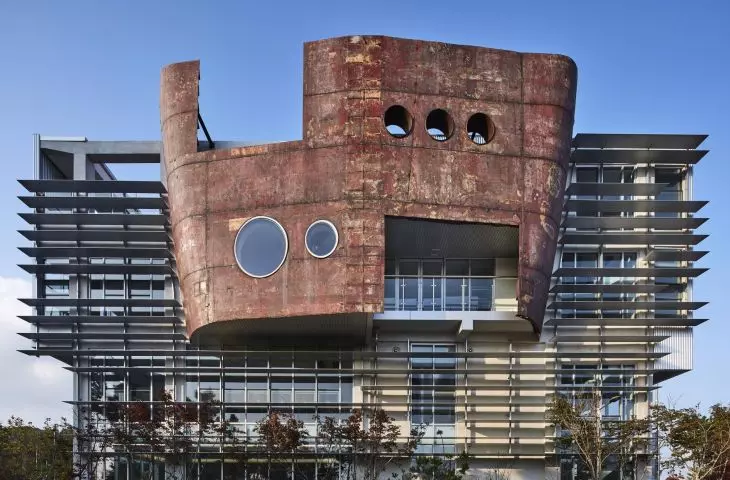Yeongjongdo Church,
design: shinslab architecture
The shinslab architecture studio, operating at the intersection of South Korea and France, has completed the design of a church, located on Yeongjongdo Island near Seoul. The building is located in the developing Jung residential area, which is being developed in accordance with the guidelines of the local development plan.
Church on Yeongjongdo Island - third floor plan
© shinslab architecture
Symbolism and upcycling in the church's design
Taking Noah's Ark as the design's leitmotif, the architects made the steel hull of the decommissioned ship the centerpiece of the mass. Its bow was symbolically pointed toward the sky. Through upcycling, steel - an industrial material characterized by exceptional durability and weather resistance - became a key structural element of the building.
Church on Yeongjongdo Island - the building was located in the developing Jung residential area
photo by Kim Yongkwan © shinslab architecture
recycled architecture
The architects first used the hull of a ship in 2016, completing the project in the spirit of upcycling as part of the YAP MMCA (Young Architects Program), organized by New York's MoMA. Yeongjongdo's church project expands on this concept, combining industrial heritage with modern sacred architecture. Ship hulls, which usually end their lives in scrap yards, gain new value here - both utilitarian and symbolic. The ship fragment has become a key element of the church's structure, bringing authenticity from their history. Marked by time and its original purpose, this steel component not only serves a structural function, but also enriches the space with a narrative layer, referring to the idea of transformation and rebirth.
Church on Yeongjongdo Island - view from the north side
© shinslab architecture
form and function of the church
The 2,700-square-meter building, laid out over five stories, including an underground level for parking and support facilities, adopts the plan of a near-square rectangle. Central sections of the ship's structure permeate through its four-story mass.
Church on Yeongjongdo Island - close-up view of the ship's bow
photo by Kim Yongkwan © shinslab architecture
The lower floors of the building are distinguished by an almost entirely glazed facade, which introduces an element of transparency and lightness, contrasting with the solid form of the upper sections. On the upper elevations, corrugated galvanized sheet metal was used, whose surface, reflecting light and sky, gives the building a lightness. The juxtaposition of steel and concrete in the structure provides stability and durability, while the use of corrugated sheet metal on the upper elevations emphasizes the building's modern character.
Church on Yeongjongdo Island - the vertically aligned bow dominates the building's composition
photo by Kim Yongkwan © shinslab architecture
elements of the ship
as an integral part of the design
The church's façade is enriched with two expressive elements derived from the ship's hull, which serve both symbolic and architectural functions. The first is the vertically positioned bow, which dominates the building's composition and forms its distinctive signature. Inside it are located the chancel and the main entrance, and the whole is crowned by a cross, located at a height of 33 meters, giving the structure a sacred and spatial dimension. The second section, located on the southern elevation, is a bay window, which introduces differentiation in the body of the church. This element highlights the building's two top floors.
Church on Yeongjongdo Island - view of the southern elevation with the bay window, which is a fragment of the vessel
photo by Kim Yongkwan © shinslab architecture
sacred and utilitarian space:
A harmonious blend of function and aesthetics
The open space on the first floor invites worshippers into the nave, the centerpiece of which is a two-story congregation hall. The second floor houses the educational area, consisting of five classrooms arranged around a central hall. This layout promotes easy orientation and smooth communication between rooms. The central prayer area is the main hall on the second floor, seating 300 people. Its interior is filled with daylight filtering through stained glass windows inspired by the work of Marc Chagall.
Church on Yeongjongdo Island - interior of the building
© shinslab architecture
The top floor is designed as an administrative area, including offices and a café with a terrace. The terrace provides users with a panoramic view of the sea, acting as a place for rest and reflection. Converted into usable space, the ship's hull has been enhanced with carefully placed openings that not only provide light and ventilation, but also frame the view of the surrounding landscape, putting the interior into the context of the natural surroundings.
Yeongjongdo Island Church - longitudinal cross section
© shinslab architecture
Yeongjongdo Island Church is an example of architecture that combines aesthetics, functionality and environmental responsibility. The building serves as a place of worship, and also symbolizes contemporary aspirations in architecture: respecting resources, upcycling and creating spaces of timeless value.
Elaborated: Anastazja Dżupina
Illustrations provided courtesy of shinslab architecture studio.
























































